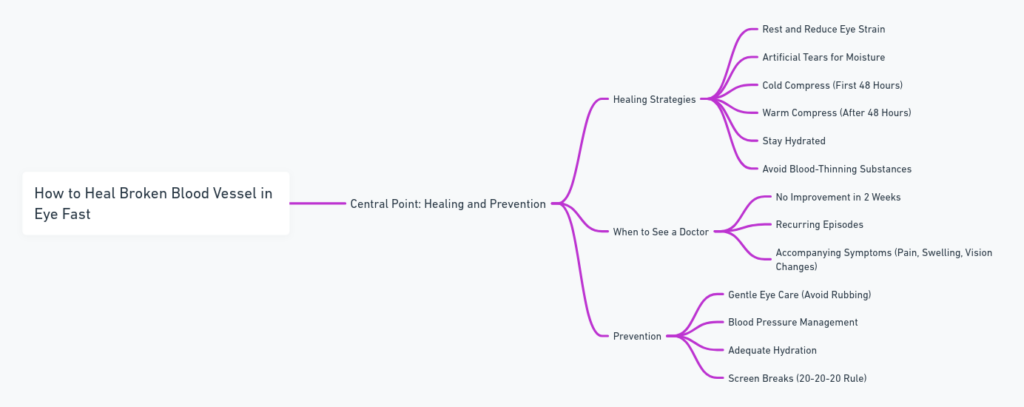How to Heal Broken Blood Vessel in Eye Fast
Ihr Leitfaden, Informationen und Tipps
Introduction: Understanding Broken Blood Vessels in the Eye
A broken blood vessel in the eye, medically referred to as a subconjunctival hemorrhage, can appear alarming but is often harmless. This condition occurs when a small blood vessel bursts beneath the clear surface of your eye, causing a red or bloodshot patch to develop. Though it may look concerning, it typically resolves without medical intervention.
For those wondering how to heal broken blood vessel in eye fast, this article provides practical tips to support the healing process, minimize discomfort, and prevent recurrence. Whether caused by sneezing, coughing, or minor injuries, understanding and addressing this condition promptly can ensure a smoother recovery.
Causes of a Broken Blood Vessel in the Eye
A broken blood vessel in the eye can result from a variety of common situations, many of which are harmless but unavoidable in daily life. Here are some primary causes:
Sneezing or Coughing: Sudden increases in pressure during a forceful sneeze or cough can cause a small blood vessel to burst.
Straining: Activities like heavy lifting or even intense vomiting may lead to ruptures in the tiny blood vessels of the eye.
Eye Rubbing or Minor Injuries: Accidentally poking or rubbing your eye too vigorously can result in damage to the delicate vessels beneath the eye’s surface.
High Blood Pressure: Elevated blood pressure can increase the likelihood of blood vessel ruptures, although this is less common.
Medications: Blood-thinning medications such as aspirin or anticoagulants can make it easier for vessels to break.
Understanding these causes can help you take preventive measures to avoid future occurrences. If you’re searching for how to heal broken blood vessel in eye fast, identifying the root cause is an essential first step.

Symptoms of a Broken Blood Vessel in the Eye
A broken blood vessel in the eye is easy to identify due to its characteristic appearance. Key symptoms include:
Bright Red Patch: A localized area of bright red blood visible on the sclera (the white part of the eye). This occurs because the blood is trapped beneath the conjunctiva, a clear membrane.
No Pain or Vision Impairment: Unlike more serious eye conditions, a subconjunctival hemorrhage typically doesn’t cause pain, swelling, or changes in vision.
Mild Irritation: Some individuals may feel a slight scratchy sensation, as though something is in their eye.
Statistics show that up to 3% of the population experiences a subconjunctival hemorrhage at least once in their lifetime, often without realizing the cause. In rare cases, recurring episodes could signal underlying health issues, such as hypertension or a bleeding disorder.
If you notice these symptoms and are researching how to heal broken blood vessel in eye fast, rest assured that in most cases, simple home remedies can promote healing within 7–14 days. However, if additional symptoms such as pain, discharge, or vision changes occur, consult a healthcare professional promptly.
How to Heal Broken Blood Vessel in Eye Fast
Healing a broken blood vessel in the eye can feel urgent, especially when it looks alarming. While it is true that most cases resolve without medical intervention, certain steps can help you recover more quickly and comfortably. Here’s a detailed approach to healing effectively:
Rest Your Eyes
- Avoid straining activities like extended screen use, reading in dim lighting, or long periods of focus-intensive tasks.
- Try to get adequate sleep to allow your eyes to naturally recover.
Use Artificial Tears
- Apply lubricating eye drops several times a day to keep your eyes moist and comfortable. This is especially helpful if irritation or a mild scratchy sensation accompanies the redness.
- Opt for preservative-free drops to avoid potential irritation from added chemicals.
Cold Compress Application
- In the first 24 to 48 hours, a cold compress helps reduce swelling and provides soothing relief.
- Wrap ice or a cold pack in a soft cloth and apply it gently to the closed eyelid for 10 minutes at a time, ensuring breaks in between.
Switch to Warm Compresses
- After the initial 48 hours, warm compresses improve blood circulation, helping your body reabsorb the trapped blood more quickly.
- Soak a clean cloth in warm water, wring it out, and place it over your closed eye for about 10–15 minutes, two to three times daily.
Stay Hydrated
- Adequate hydration supports healthy blood flow and can expedite the reabsorption of the blood beneath the conjunctiva.
- Aim for at least 8 glasses of water daily, or more if you’re active.
Avoid Blood-Thinning Substances
- Skip over-the-counter medications like aspirin or ibuprofen unless prescribed, as they can slow the clotting process.
- Refrain from consuming alcohol or smoking, which may exacerbate the issue.
Gentle Eye Care
- Avoid rubbing or pressing on the eye, even if it feels slightly irritated.
- Use protective eyewear in windy or dusty conditions to prevent additional irritation.
By following these steps, you can significantly reduce discomfort and ensure faster healing of the broken blood vessel in your eye. Most cases resolve within 7 to 14 days. However, it’s important to monitor your symptoms and consult a doctor if there are any concerns, such as prolonged redness or accompanying pain.

Back
Greyblue
Ravi
Sapphire Blue
“Simple remedies and preventative care can help a broken blood vessel in your eye heal fast and keep your vision healthy.”
When to See a Doctor
While most cases resolve on their own, you should seek medical attention if:
The redness doesn’t improve within two weeks.
You experience recurring episodes of subconjunctival hemorrhage.
There is accompanying pain, swelling, vision changes, or discharge.
You have a bleeding disorder or are on blood-thinning medication.
A healthcare professional can rule out underlying conditions like diabetes, hypertension, or eye trauma, ensuring you receive the appropriate care.
Prevention Tips
Preventing a broken blood vessel in the eye involves protecting your eyes and maintaining overall health:
Practice Gentle Eye Care: Avoid rubbing your eyes excessively and use protective eyewear during activities that may cause injury.
Manage Blood Pressure: Keep your blood pressure under control with a healthy diet, regular exercise, and medication if needed.
Stay Hydrated: Proper hydration helps maintain healthy blood vessels.
Take Breaks from Screens: Follow the 20-20-20 rule: Every 20 minutes, look at something 20 feet away for 20 seconds to reduce eye strain.
By taking these steps, you can reduce the likelihood of a broken blood vessel and maintain good eye health over the long term.

